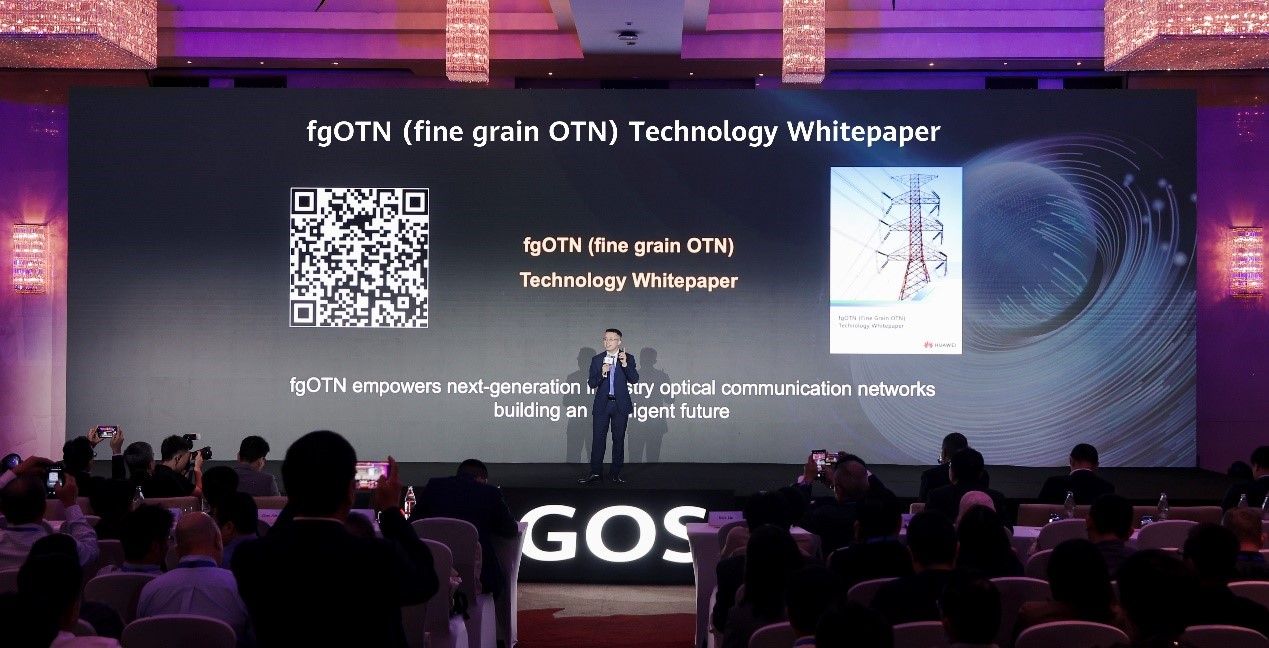Enterprise products, solutions & services
[Bangkok, Thailand, April 30, 2024] During Global Optical Summit(GOS) APAC 2024, Huawei released the fgOTN Technical White Paper (referred to as White Paper). The White Paper provides a detailed description on the fine grain OTN (fgOTN) standard series, key technologies, and application scenarios, proposes the industry target network architecture based on the fgOTN standards, and describes the prospect of future optical communication applications in a range of industries.

Huawei Releases the fgOTN Technical White Paper
Industries such as energy and transportation are critical to a country's economy and people's livelihood. As a fundamental part in the production system, communications networks have high requirements on security and reliability. In the past few decades, industry production networks have mainly used SDH hard pipe communication technology. However, amid industry digitalization, services such as unattended inspection and smart power distribution have experienced rapid development, creating a need for higher bandwidth, efficient transmission of masses of fine-granularity services, and future-oriented production communication networks. fgOTN is an optical transport technology standard defined and released by the International Telecommunication Union-Telecommunication Standardization Sector (ITU-T). It is clearly defined as the next-generation optical technology for SDH evolution. Besides SDH, fgOTN is the industry's only technology that has international standards to support constant bit rate (CBR) service transmission. It can also efficiently carry Ethernet services and support fast hitless bandwidth adjustment. What's more, it can be widely used in private networks in industries such as electric power and transportation as well as carriers' enterprise private lines, thereby meeting the requirements of intelligent services for communication networks.
fgOTN inherits two advantages of SDH and supports CBR service transmission:
1. Fixed timeslot: fgOTN inherits the signal structure based on fixed TDM timeslots, adopts fixed timeslots and timeslot occupation modes, uses physical isolation to ensure service security and reliability, and achieves SDH-like stability and low latency.
2. Even mapping: fgOTN inherits the transmission mode of sub-1G services. Service signals are evenly mapped to fgOTN containers using Generic Mapping Procedure (GMP) to ensure a constant service transmission rate.
In addition, compared with SDH, fgOTN features the following technical improvements:
1. Bandwidth increase: fgOTN is further improved based on OTN standards. It provides the same bandwidth as OTN on the line side and supports more than ten times the bandwidth of SDH. To be specific, it supports 100G and future evolution to 800G per wavelength, meeting the increasing bandwidth requirements of intelligent services.
2. Transmission efficiency improvement: The transmission efficiency of small-granularity services is improved. The minimum granularity supported by fgOTN is 10M, and the bandwidth can be adjusted on demand at a step of 10M, achieving higher transmission efficiency and flexibility. In addition, the number of mapping layers is reduced by 1 to 3, achieving lower service latency.
3. Service management optimization: fgOTN services ranging from 10 Mbit/s to 1 Gbit/s can be transported through one fgODUflex channel. SDH services, in contrast, need to be transported through multiple VCs.
4. Clock synchronization optimization: fgOTN supports associated clock adjustment, and does not require network-wide clock synchronization. Associated clock adjustment can be directly performed based on service clock information to ensure clock information consistency on transmission paths.
Nick Liu, Vice President of Huawei Enterprise Optical Network Domain, said, "Looking ahead, the application of fgOTN requires close cooperation among customers in industries such as electric power and transportation, as well as telecom carriers and communications vendors. Huawei will work with customers and partners to continuously explore the application framework and scenarios of fgOTN, and will jointly promote the rapid development of fgOTN technologies and standards as well as the fast commercial use of devices."
For more information about the fgOTN Technical White Paper, please visit:
https://e.huawei.com/en/material/optical/0cd848b119e949d29fead3f9246e82f0